maintenance schedule DODGE VIPER 2008 ZB II / 2.G Owners Manual
[x] Cancel search | Manufacturer: DODGE, Model Year: 2008, Model line: VIPER, Model: DODGE VIPER 2008 ZB II / 2.GPages: 303, PDF Size: 2.65 MB
Page 2 of 303
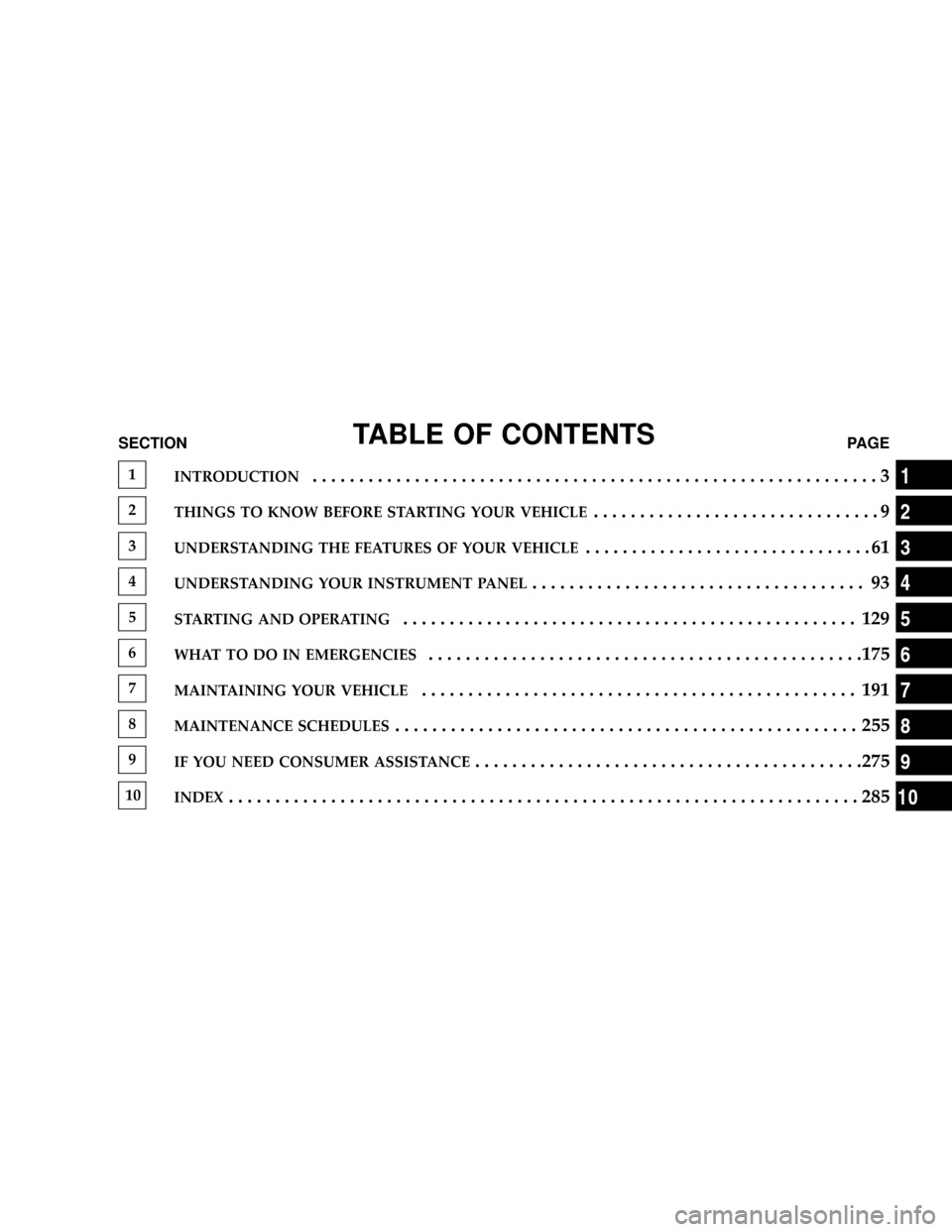
TABLE OF CONTENTSSECTIONPAGE
1INTRODUCTION.............................................................3
2THINGS TO KNOW BEFORE STARTING YOUR VEHICLE...............................9
3UNDERSTANDING THE FEATURES OF YOUR VEHICLE...............................61
4UNDERSTANDING YOUR INSTRUMENT PANEL.................................... 93
5STARTING AND OPERATING................................................. 129
6WHAT TO DO IN EMERGENCIES...............................................175
7MAINTAINING YOUR VEHICLE............................................... 191
8MAINTENANCE SCHEDULES.................................................. 255
9IF YOU NEED CONSUMER ASSISTANCE..........................................275
10INDEX....................................................................285
1
2
3
4
5
6
7
8
9
10
Page 166 of 303
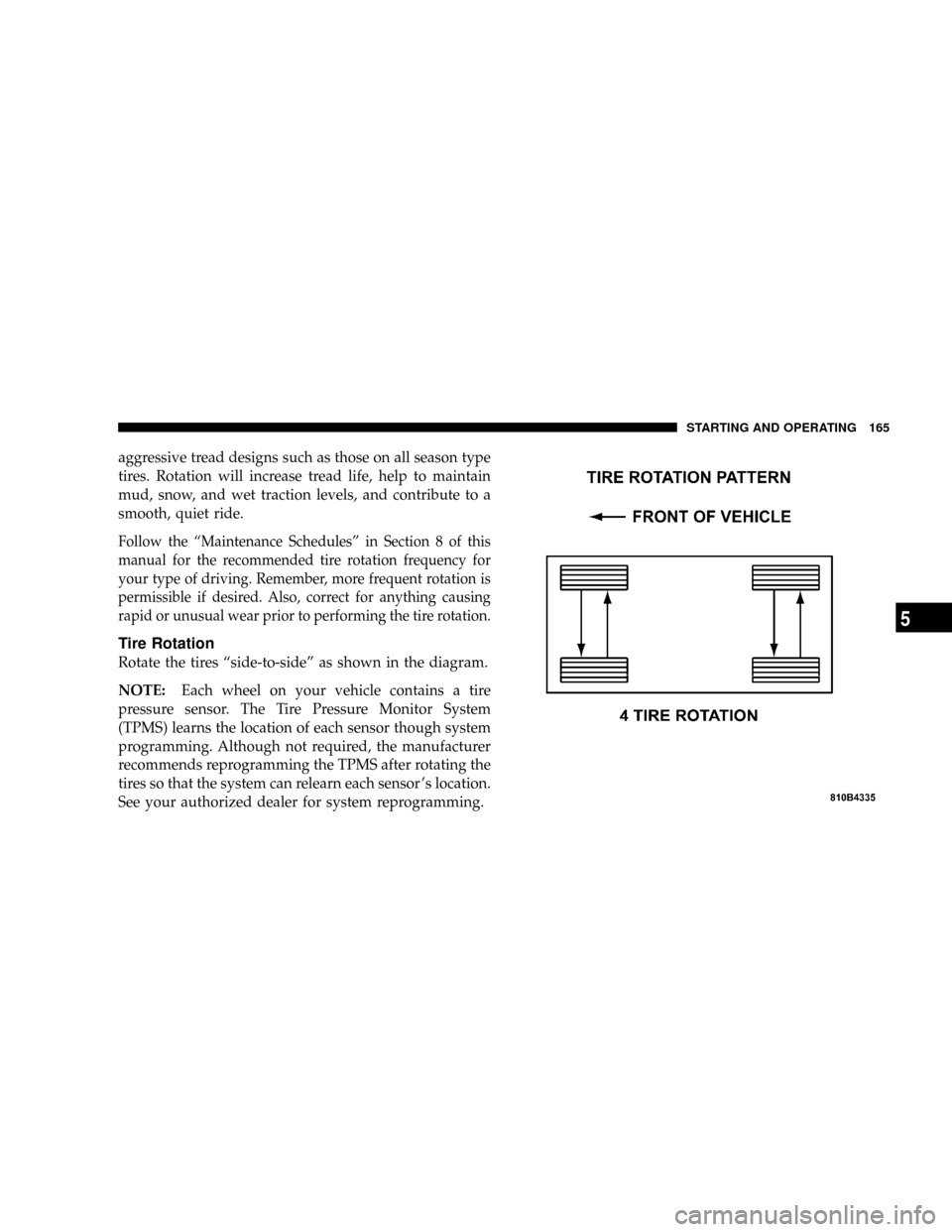
aggressive tread designs such as those on all season type
tires. Rotation will increase tread life, help to maintain
mud, snow, and wet traction levels, and contribute to a
smooth, quiet ride.
Follow the ªMaintenance Schedulesº in Section 8 of this
manual for the recommended tire rotation frequency for
your type of driving. Remember, more frequent rotation is
permissible if desired. Also, correct for anything causing
rapid or unusual wear prior to performing the tire rotation.
Tire Rotation
Rotate the tires ªside-to-sideº as shown in the diagram.
NOTE:Each wheel on your vehicle contains a tire
pressure sensor. The Tire Pressure Monitor System
(TPMS) learns the location of each sensor though system
programming. Although not required, the manufacturer
recommends reprogramming the TPMS after rotating the
tires so that the system can relearn each sensor 's location.
See your authorized dealer for system reprogramming.
STARTING AND OPERATING 165
5
Page 198 of 303

5. Approximately 15 seconds later, one of two things will
happen:
a. The MIL will flash for about 10 seconds and then
return to being fully illuminated until you turn off the
ignition key or start the engine. This means that your
vehicle's OBD system isnot readyand you shouldnot
proceed to the I/M station.
b. The MIL will not flash at all and will remain fully
illuminated until you turn OFF the ignition key or start
the engine. This means that your vehicle's OBD system
isreadyand you can proceed to the I/M station.
If your OBD system isnot ready,you should see your
authorized dealer or repair facility. If your vehicle was
recently serviced or had a battery failure or replacement,
you may need to do nothing more than drive your
vehicle as you normally would in order for your OBD
system to update. A recheck with the above test routine
may then indicate that the system is now ready.Regardless of whether your vehicle's OBD system is
ready or not ready, if the MIL symbol is illuminated
during normal vehicle operation, you should have your
vehicle serviced before going to the I/M station. The I/M
station can fail your vehicle because the MIL symbol is on
with the engine running.
REPLACEMENT PARTS
Use of genuine Mopartparts for normal/scheduled
maintenance and repairs is highly recommended to en-
sure the designed performance. Damage or failures
caused by the use of non-Mopartparts for maintenance
and repairs will not be covered by the manufacturer's
warranty.
MAINTAINING YOUR VEHICLE 197
7
Page 201 of 303
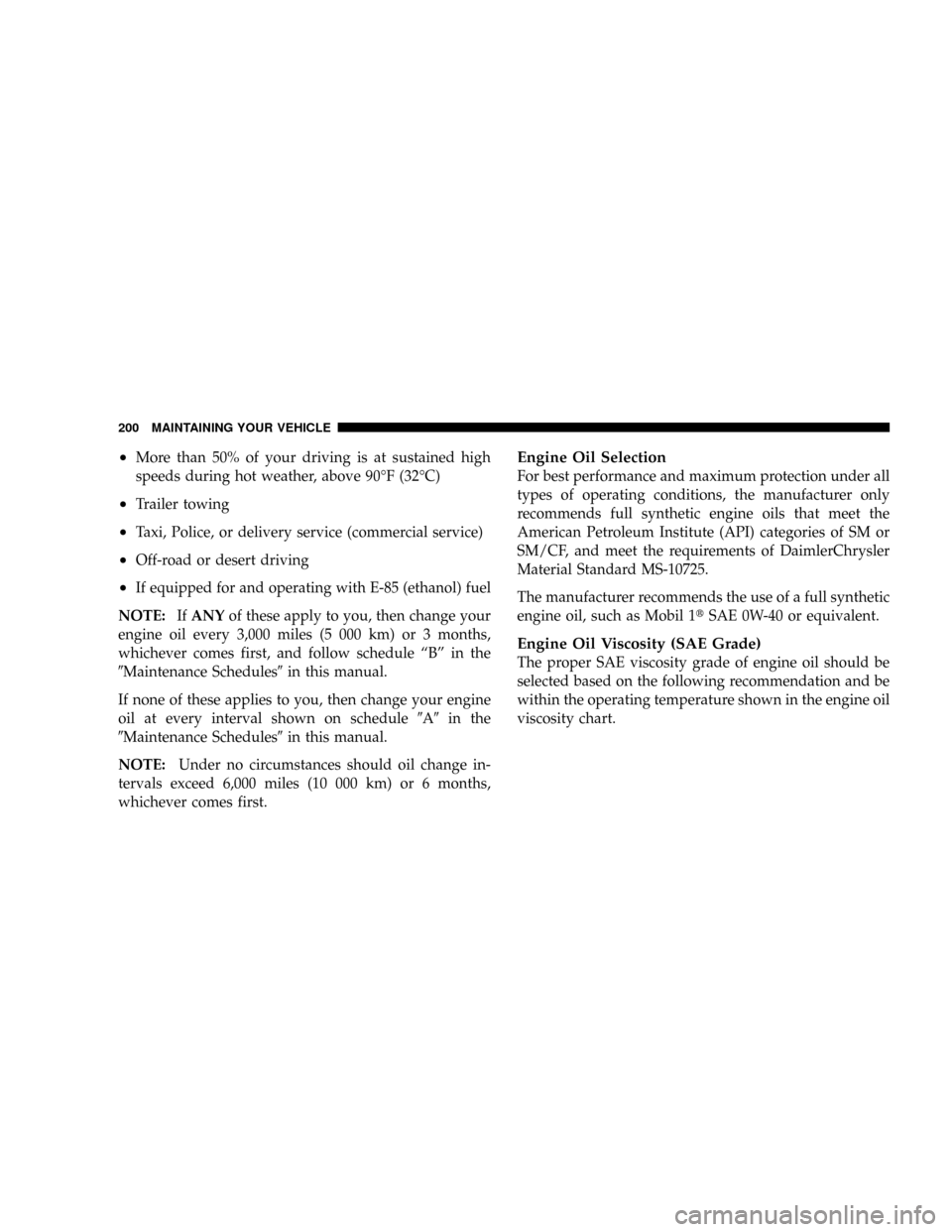
²More than 50% of your driving is at sustained high
speeds during hot weather, above 90ÉF (32ÉC)
²Trailer towing
²Taxi, Police, or delivery service (commercial service)
²Off-road or desert driving
²If equipped for and operating with E-85 (ethanol) fuel
NOTE:IfANYof these apply to you, then change your
engine oil every 3,000 miles (5 000 km) or 3 months,
whichever comes first, and follow schedule ªBº in the
9Maintenance Schedules9in this manual.
If none of these applies to you, then change your engine
oil at every interval shown on schedule9A9in the
9Maintenance Schedules9in this manual.
NOTE:Under no circumstances should oil change in-
tervals exceed 6,000 miles (10 000 km) or 6 months,
whichever comes first.
Engine Oil Selection
For best performance and maximum protection under all
types of operating conditions, the manufacturer only
recommends full synthetic engine oils that meet the
American Petroleum Institute (API) categories of SM or
SM/CF, and meet the requirements of DaimlerChrysler
Material Standard MS-10725.
The manufacturer recommends the use of a full synthetic
engine oil, such as Mobil 1tSAE 0W-40 or equivalent.
Engine Oil Viscosity (SAE Grade)
The proper SAE viscosity grade of engine oil should be
selected based on the following recommendation and be
within the operating temperature shown in the engine oil
viscosity chart.
200 MAINTAINING YOUR VEHICLE
Page 204 of 303

Spark Plugs
Spark plugs must fire properly to assure engine perfor-
mance and emission control. New plugs should be in-
stalled at the specified mileage. The entire set should be
replaced if there is any malfunction due to a faulty spark
plug. Malfunctioning spark plugs can damage the cata-
lytic converter. Refer to ªFluids, Lubricants, and Genuine
Partsº in this section for the proper type of spark plug for
use in your vehicle.
Engine Air Cleaner Filter
For normal driving conditions, inspect and replace the
engine air cleaner filter at the intervals shown on Sched-
ule ªA.º For vehicles driven frequently in dusty or under
severe conditions, inspect and replace the engine air
cleaner filter at the intervals shown on Schedule ªB.º
WARNING!
The air induction system (air cleaner, hoses, etc) can
provide a measure of protection in the case of engine
backfire. Do not remove the air induction system (air
cleaner, hoses, etc) unless such removal is necessary
for repair or maintenance. Make sure that no one is
near the engine compartment before starting the
vehicle with the air induction system (air cleaner,
hoses, etc) removed. Failure to do so can result in
serious personal injury.
MAINTAINING YOUR VEHICLE 203
7
Page 215 of 303

WARNING!
Overfilling the power steering fluid reservoir can
result in spilling power steering fluid on hot engine
parts and the power steering fluid catching fire.
Front & Rear Suspension Ball Joints
This vehicle has suspension ball joints that require peri-
odic inspection and lubrication.
Inspection
The ball joints should be inspected whenever other
service or maintenance is performed on the vehicle.
Damaged seals should be replaced to prevent leakage or
contamination of the grease. If there is any movement
within the ball joint, the knuckle or control arm must be
replaced, as the ball joints are not serviceable by them-
selves. See your authorized dealer for service.
Lubrication
The ball joints are lubricated at the factory with special
grease. Therefore, when lubricating the ball joints, use
only special long life chassis grease such as Multi-
Mileage Lubricant, which is intended for this purpose.
Refer to the ªMaintenance Schedulesº in this manual for
the specified lubrication intervals.
Steering Linkage
There are two tie rod end ball joints that require periodic
inspection.
Inspection
The ball joint seals on the tie rod ends should be
inspected whenever other service or maintenance is
performed on the vehicle. Damaged seals should be
replaced to prevent leakage or contamination of the
grease. If damaged, the tie rod end must be replaced, as
the seals are not serviceable by themselves. See your
authorized dealer for service.
214 MAINTAINING YOUR VEHICLE
Page 221 of 303
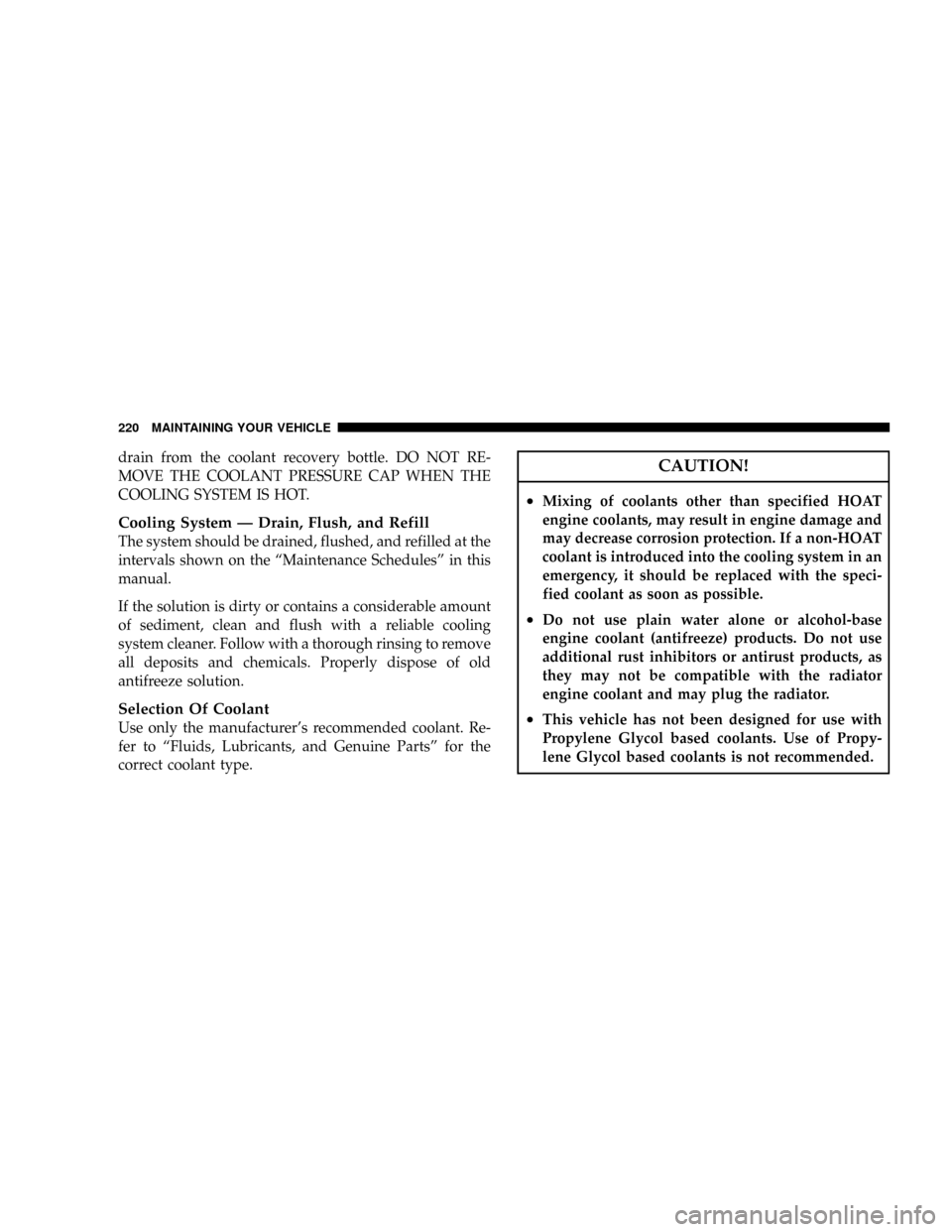
drain from the coolant recovery bottle. DO NOT RE-
MOVE THE COOLANT PRESSURE CAP WHEN THE
COOLING SYSTEM IS HOT.
Cooling System Ð Drain, Flush, and Refill
The system should be drained, flushed, and refilled at the
intervals shown on the ªMaintenance Schedulesº in this
manual.
If the solution is dirty or contains a considerable amount
of sediment, clean and flush with a reliable cooling
system cleaner. Follow with a thorough rinsing to remove
all deposits and chemicals. Properly dispose of old
antifreeze solution.
Selection Of Coolant
Use only the manufacturer's recommended coolant. Re-
fer to ªFluids, Lubricants, and Genuine Partsº for the
correct coolant type.
CAUTION!
²Mixing of coolants other than specified HOAT
engine coolants, may result in engine damage and
may decrease corrosion protection. If a non-HOAT
coolant is introduced into the cooling system in an
emergency, it should be replaced with the speci-
fied coolant as soon as possible.
²Do not use plain water alone or alcohol-base
engine coolant (antifreeze) products. Do not use
additional rust inhibitors or antirust products, as
they may not be compatible with the radiator
engine coolant and may plug the radiator.
²This vehicle has not been designed for use with
Propylene Glycol based coolants. Use of Propy-
lene Glycol based coolants is not recommended.
220 MAINTAINING YOUR VEHICLE
Page 226 of 303
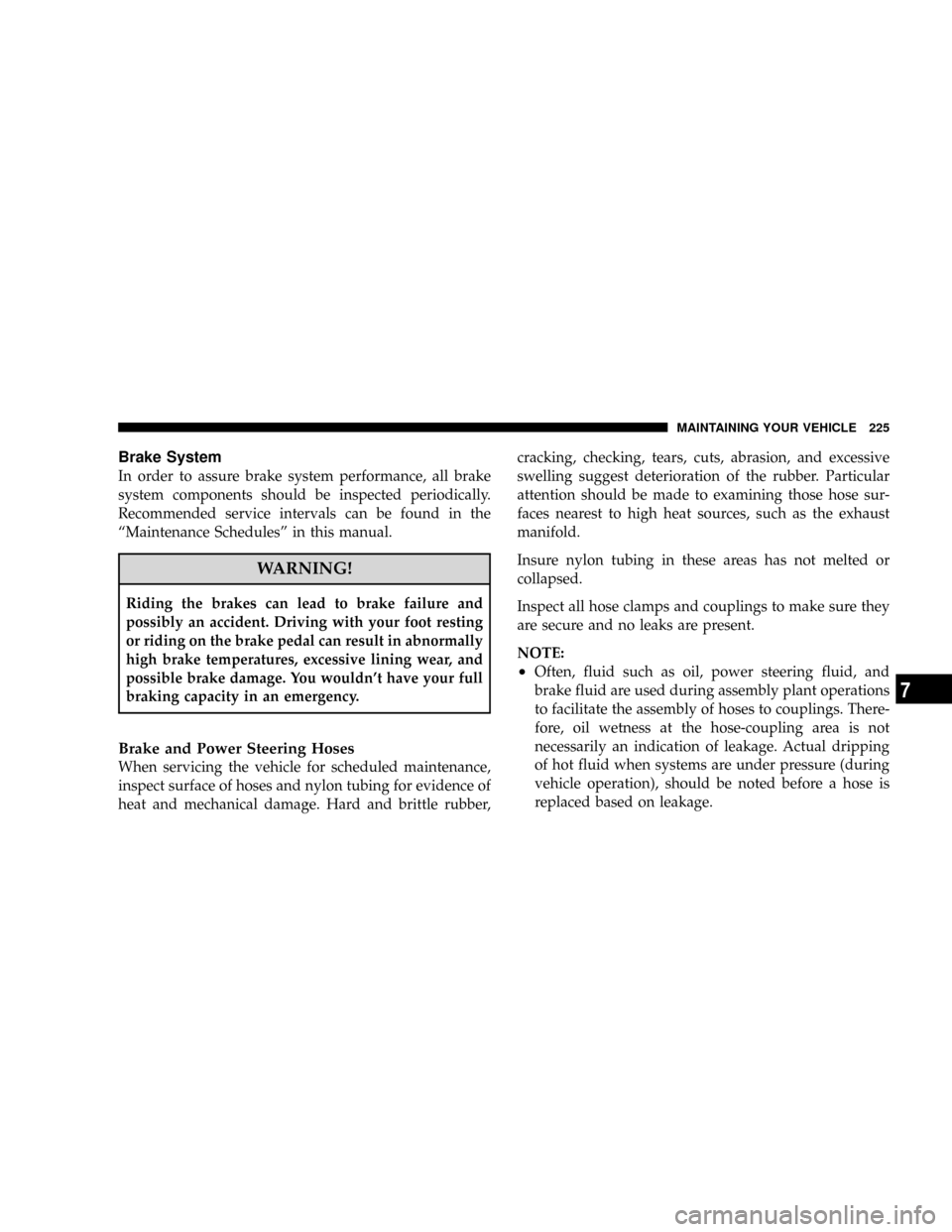
Brake System
In order to assure brake system performance, all brake
system components should be inspected periodically.
Recommended service intervals can be found in the
ªMaintenance Schedulesº in this manual.
WARNING!
Riding the brakes can lead to brake failure and
possibly an accident. Driving with your foot resting
or riding on the brake pedal can result in abnormally
high brake temperatures, excessive lining wear, and
possible brake damage. You wouldn't have your full
braking capacity in an emergency.
Brake and Power Steering Hoses
When servicing the vehicle for scheduled maintenance,
inspect surface of hoses and nylon tubing for evidence of
heat and mechanical damage. Hard and brittle rubber,cracking, checking, tears, cuts, abrasion, and excessive
swelling suggest deterioration of the rubber. Particular
attention should be made to examining those hose sur-
faces nearest to high heat sources, such as the exhaust
manifold.
Insure nylon tubing in these areas has not melted or
collapsed.
Inspect all hose clamps and couplings to make sure they
are secure and no leaks are present.
NOTE:
²Often, fluid such as oil, power steering fluid, and
brake fluid are used during assembly plant operations
to facilitate the assembly of hoses to couplings. There-
fore, oil wetness at the hose-coupling area is not
necessarily an indication of leakage. Actual dripping
of hot fluid when systems are under pressure (during
vehicle operation), should be noted before a hose is
replaced based on leakage.
MAINTAINING YOUR VEHICLE 225
7
Page 228 of 303
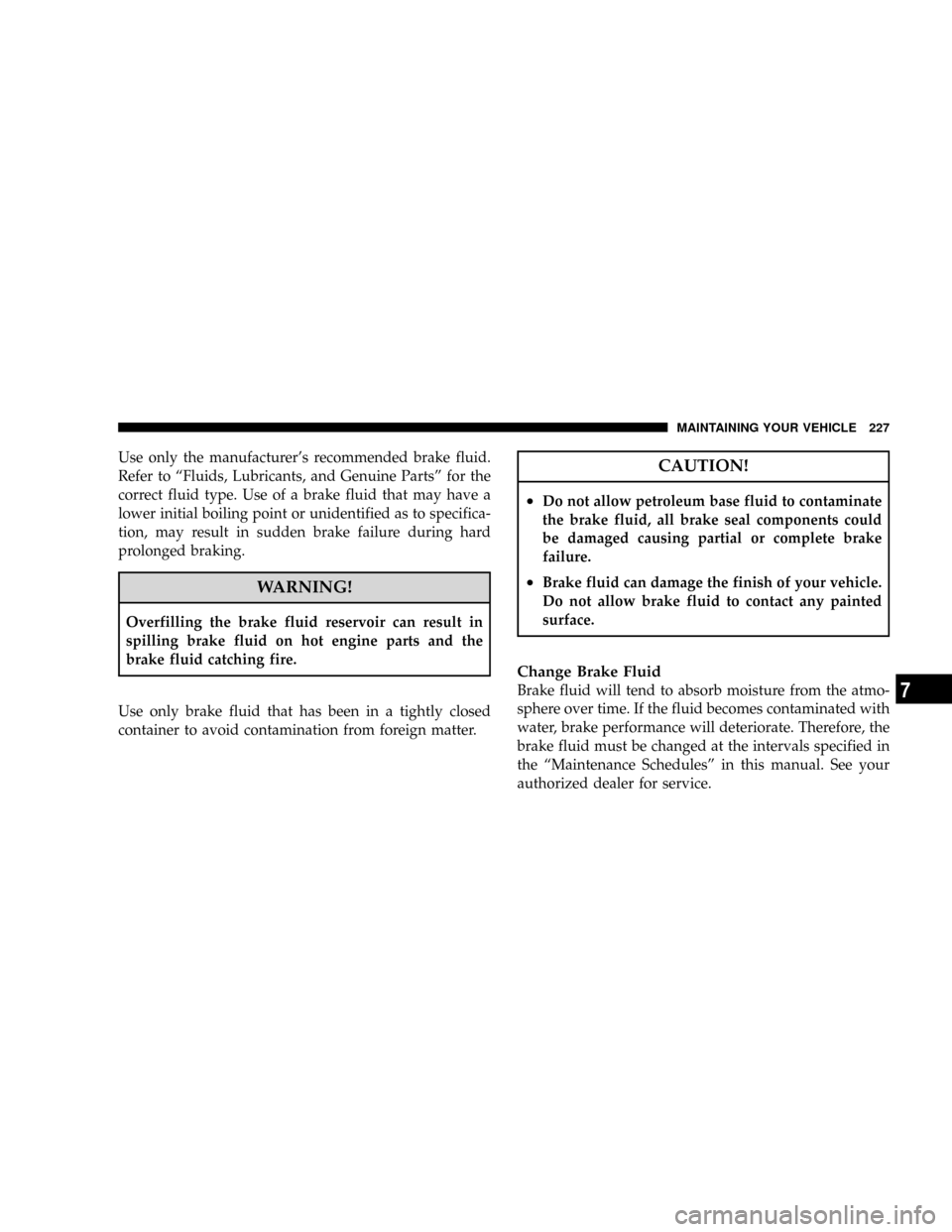
Use only the manufacturer's recommended brake fluid.
Refer to ªFluids, Lubricants, and Genuine Partsº for the
correct fluid type. Use of a brake fluid that may have a
lower initial boiling point or unidentified as to specifica-
tion, may result in sudden brake failure during hard
prolonged braking.
WARNING!
Overfilling the brake fluid reservoir can result in
spilling brake fluid on hot engine parts and the
brake fluid catching fire.
Use only brake fluid that has been in a tightly closed
container to avoid contamination from foreign matter.
CAUTION!
²Do not allow petroleum base fluid to contaminate
the brake fluid, all brake seal components could
be damaged causing partial or complete brake
failure.
²Brake fluid can damage the finish of your vehicle.
Do not allow brake fluid to contact any painted
surface.
Change Brake Fluid
Brake fluid will tend to absorb moisture from the atmo-
sphere over time. If the fluid becomes contaminated with
water, brake performance will deteriorate. Therefore, the
brake fluid must be changed at the intervals specified in
the ªMaintenance Schedulesº in this manual. See your
authorized dealer for service.
MAINTAINING YOUR VEHICLE 227
7
Page 230 of 303
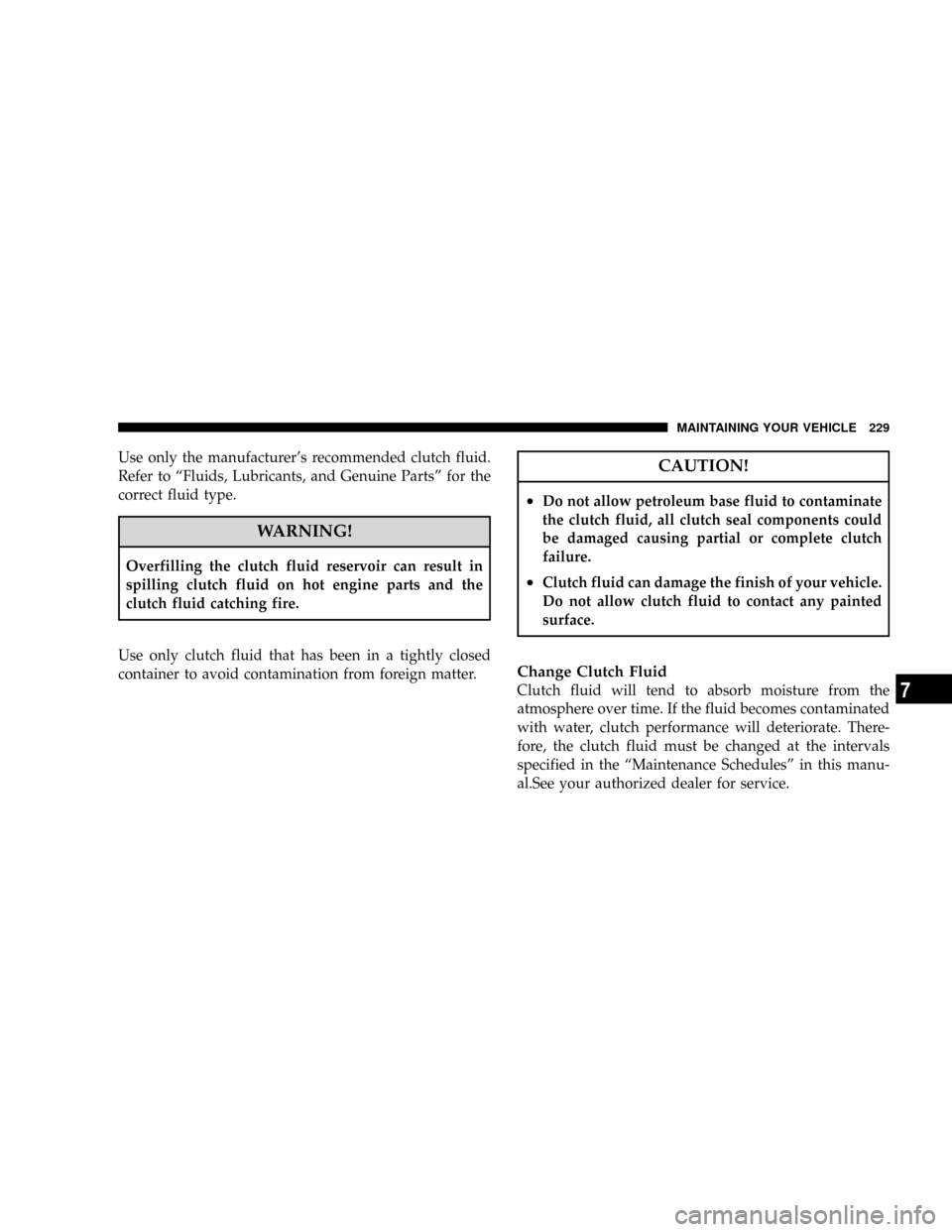
Use only the manufacturer's recommended clutch fluid.
Refer to ªFluids, Lubricants, and Genuine Partsº for the
correct fluid type.
WARNING!
Overfilling the clutch fluid reservoir can result in
spilling clutch fluid on hot engine parts and the
clutch fluid catching fire.
Use only clutch fluid that has been in a tightly closed
container to avoid contamination from foreign matter.
CAUTION!
²Do not allow petroleum base fluid to contaminate
the clutch fluid, all clutch seal components could
be damaged causing partial or complete clutch
failure.
²Clutch fluid can damage the finish of your vehicle.
Do not allow clutch fluid to contact any painted
surface.
Change Clutch Fluid
Clutch fluid will tend to absorb moisture from the
atmosphere over time. If the fluid becomes contaminated
with water, clutch performance will deteriorate. There-
fore, the clutch fluid must be changed at the intervals
specified in the ªMaintenance Schedulesº in this manu-
al.See your authorized dealer for service.
MAINTAINING YOUR VEHICLE 229
7